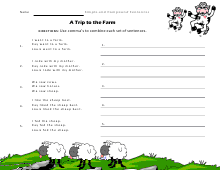Sentence Writing Worksheets
Most of the students that I work with usually start writing with major run-on sentences. For that reason, I often like to start with punctuation lessons to serve as a lead-in for this skill. When you are working on your ability to create dynamic and coherent sentences it is imperative to do away with an unnecessary words and phrases. The one thing I wish I would have instilled in my writing at an earlier age is that shorter is almost always better. The best way to know if a sentence that you have written flows properly is to read it aloud. These worksheets will help you flex your sentence writing muscles and see if they can help you write better.
Affirmatives - The goal of these statements is to assert something in a positive fashion. It is often used to confirm truthful statements or testimony.
Combining, Expanding, and Reducing Sentences - When it just does not sound right, we show you how to make a series of adjustments.
Complex Sentences - This is when you might have one too many clauses sticking around.
Connecting Sentences to Paragraphs - This helps us learn how to sum up our thoughts and keep the language flowing well.
Contrast Clauses - This are often used to enter something unsuspectingly into your work. We work on identifying them and using them in our own writing.
Diagramming Sentences - This is a way to visualize everything going on. It is a great way to validate your grammar and mechanics.
Expanding Sentences - You will need to do this in some situations because you left out detail. I often find students attempting to do this to fill up required assigned word counts for essays.
Features of Sentences - How will you find anything that may be missing or is present in excess, we do that for you?
Forming Questions - How do you begin to take things in a direction that compels the listener to answer?
Inversions - This is when the subject and the verb switch their order.
Negation - When you need to take the complete polar opposite side of a statement.
Rearranging Them - When the language does not sort out well for you, we explore how to make adjustments.
Sentence Based Response To Prompts - We ask you to complete a full thought based on the writing prompt that you are confronted with.
Sentence Completion - We start by recognizing what is missing and then we either add it or completely rewrite it.
Sentence Patterns - We pay attention to the phrases and clauses that are found here.
Simple, Compound, and Complex Forms - It all depends on the types of clauses and how many are present.
Simple Sentences with High Frequency Words - You should be awfully familiar with this vocabulary by now.
Tag Questions - These are statements that are followed up by short questions. They are used to validate information.
Topic Sentences - These are used to summarizes what is discussed over the course of a paragraph.
Types of Sentences - We examine the four common types of sentences and how to use each in your writing.
Writing Appropriate Complete Sentences - This is all about paying attention to detail and understanding how to approach each statement.
Get FREE English Worksheets In Your Email
